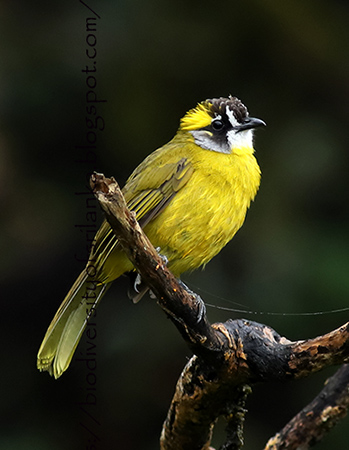English Post >>
Pages
- Home
- Flora of Sri Lanka
- Dragonflies & Damselflies of Sri Lanka
- Butterflies of Sri Lanka
- Freshwater Fishes of of Sri Lanka
- Amphibians of Sri Lanka
- Snakes of Sri Lanka
- Tetrapod Reptiles of Sri Lanka
- Mammals of Sri Lanka
- Resident Birds of Sri Lanka
- Migrant Birds of Sri Lanka
- Vagrant Birds of Sri Lanka
- Status Uncertain or Doubtful Birds of Sri Lanka
Saturday, March 30, 2024
ගළුගුඩු කොණ්ඩයා/බැම සුදු කොණ්ඩයා (Pycnonotus luteolus)
Sunday, November 12, 2023
කහ කොණ්ඩයා/බැම කහ ගුලූගුඩුවා (Actritillas indica)
English Post >>
Tuesday, June 15, 2021
කොන්ඩ කුරුල්ලා (Pycnonotus cafer)
ගෙවතු, වගා බිම්, බඩවැටි වල මෙන්ම වනාන්තර මායිම් වලද දිවයින පුරාම පාහේ හමුවන සුලභ දේශිය පක්ෂියෙකි. නමුත් වනාන්තර අභ්යන්තරයේ හමු නොවේ. ජෝඩු වශයෙන් හෝ ඇතැම් විට කුඩා රංචු වශයෙන් දිවිගෙවන කොන්ඩ කුරුල්ලන් කුඩා ගෙඩි වර්ග සහ කෘමීන් ආහාරයට ගනී. වසර පුරාම කිහිප පාරක්ම අභිජනනයේ යෙදෙන පක්ෂියෙකු වුවත් මාර්තු සිට මැයි දක්වා සහ නැවතත් අගෝස්තු සිට සැප්තැම්බර් දක්වා කාලයේ ප්රධාන අභිජනන සමයන් ඇති බව නිරීක්ෂණය කර ඇත. කුඩා කෝටු කැබැලි, පරඩැල්, මුල් කැබැලි ආදිය යොදා මකුලුදැල් වලින් ඒවා එක් කර සාදන කෝප්පයක භැඩැති කූඩුවක බිත්තර 2 ක් හෝ 3 ක් දමා අභිජනනයේ යෙදේ.
English Post >>
Tuesday, April 13, 2021
හිස කළු කොණ්ඩයා/ශ්රී ලංකා කළු ඉසැසි කොණ්ඩයා (Pycnonotus melanicterus)
පහත රට ප්රදේශ වල සිට කඳුකරයේ මධ්යම ප්රදේශ දක්වා වනාන්තර, වෙනත් එවැනි ගස් කොළන් බහුල ස්ථාන සහ ආශ්රීත ගෙවතු වල ස්ථානීය වශයෙන් සුලභ මෙරටට ආවේනික පක්ෂියෙකි. නමුත් තෙත් කලාපයේ සහ වියලි කලාපීය ගංගා දෙපස පිහිටි වනාන්තර වල වඩාත් සුලභය. ජෝඩු වශයෙන් හෝ කුඩා රංචු වශයෙන් දිවිගෙවන හිස කළු කොණ්ඩයන් ප්රධාන වශයෙන් පළතුරු, කුඩා ගෙඩි ජාති මෙන්ම කෘමි සතුන්ද ආහාරයට ගනී. වසරේ මාර්තු සිට අප්රේල් දක්වා සහ නැවතත් අගෝස්තු සිට සැප්තැම්බර් දක්වා පඳුරු අතර හෝ කුඩා ගසක අතු පතර මනාව සැඟවුන ස්ථානයක කෝප්පයක හැඩය සහිත කූඩුවක් තනා අභිජනනයේ යෙදේ.
English Post >>
Friday, December 25, 2020
ශ්රී ලංකා කහකන් කොණ්ඩයා/ගුරු කොණ්ඩයා (Pycnonotus penicillatus)

English Post >>
Thursday, April 9, 2020
කළු කොණ්ඩයා/කළු පිරි-කොණ්ඩයා (Hypsipetes leucocephalus)
English Post >>
Thursday, December 19, 2013
Yellow-eared Bulbul(Pycnonotus penicillatus)
Friday, January 11, 2013
කොන්ඩ කුරුල්ලා[Konda kurulla]/Red-vented Bulbul (Pycnonotus cafer)
Saturday, September 1, 2012
Black Bulbul (Hypsipetes leucocephalus)

Sunday, July 1, 2012
Black-capped Bulbul (Pycnonotus melanicterus)









